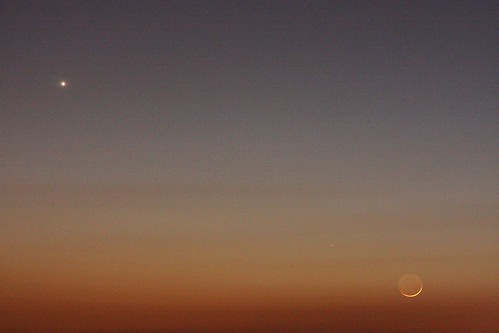Over the next few weeks, the International Space Station can be easily seen flying over the UK. Its solar panels are the size of a football field, allowing the space station to be easily seen from the ground as they reflect plenty of sunlight.
Times when the space station can be seen for the next week are below, or at either SpaceWeather.com, or on Heavens-Above.com. Although these times are exact for Brighton, the times will be within half a minute of these times for anywhere in the UK, or you can simply follow those links and type in a new location.
The table below gives the time and position of the International Space Station as it starts to fly over the UK, reaches the maximum height and the time when it disappears (ends).
In the table, Alt. refers to the altitude of the space craft as it flies overhead (90° is directly overhead, and 0° is the horizon); Az. is the Azimuth, or direction, of where it will be at the given time (0° being North, 90°: is East, 180° is South and 270° is West).
Date | Starts | Max. height | Ends | ||||||
| Time | Alt. | Az. | Time | Alt. | Az. | Time | Alt. | Az. | |
| 29 Apr | 21:41:07 | 10 | SSW | 21:43:40 | 26 | SSE | 21:44:24 | 23 | ESE |
| 30 Apr | 22:05:51 | 10 | SW | 22:08:45 | 53 | SSE | 22:09:58 | 29 | E |
| 1 May | 20:56:20 | 10 | SSW | 20:58:54 | 27 | SSE | 21:01:30 | 10 | E |
| 1 May | 22:30:59 | 10 | WSW | 22:33:57 | 89 | SSE | 22:34:54 | 40 | ENE |
| 2 May | 21:21:03 | 10 | WSW | 21:23:57 | 55 | SSE | 21:26:52 | 10 | E |
| 2 May | 22:56:14 | 10 | W | 22:59:12 | 73 | N | 22:59:26 | 67 | NE |
| 3 May | 21:46:08 | 10 | WSW | 21:49:07 | 89 | N | 21:52:05 | 10 | ENE |
| 3 May | 23:21:28 | 10 | W | 23:23:44 | 48 | WNW | 23:23:44 | 48 | WNW |
| 4 May | 20:36:08 | 10 | WSW | 20:39:03 | 58 | SSE | 20:41:59 | 10 | E |
| 4 May | 22:11:21 | 10 | W | 22:14:19 | 73 | N | 22:16:22 | 18 | E |
| 5 May | 21:01:12 | 10 | W | 21:04:11 | 87 | N | 21:07:08 | 10 | E |
| 5 May | 22:36:31 | 10 | W | 22:39:30 | 82 | N | 22:40:24 | 41 | E |
| 6 May | 21:26:22 | 10 | W | 21:29:20 | 73 | N | 21:32:17 | 10 | E |
| 6 May | 23:01:39 | 10 | WNW | 23:04:22 | 61 | SW | 23:04:22 | 61 | SW |



